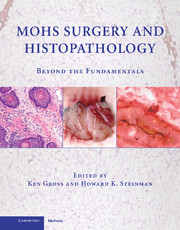Book contents
- Frontmatter
- Contents
- CONTRIBUTORS
- MOHS SURGERY AND HISTOPATHOLOGY
- PART I MICROSCOPY AND TISSUE PREPARATION
- PART II INTRODUCTION TO LABORATORY TECHNIQUES
- PART III MICROANATOMY AND NEOPLASTIC DISEASE
- Chap. 11 NORMAL MICROANATOMY: VERTICAL AND HORIZONTAL
- Chap. 12 BASAL CELL CARCINOMA: VERTICAL AND HORIZONTAL
- Chap. 13 SQUAMOUS CELL CARCINOMA: VERTICAL AND HORIZONTAL
- Chap. 14 UNUSUAL TUMORS: VERTICAL AND HORIZONTAL
- Chap. 15 MOHS FOR MELANOMA
- Chap. 16 TAKING STAGES BEYOND STAGE I
- Chap. 17 PERINEURAL TUMORS
- PART IV SPECIAL TECHNIQUES AND STAINS
- INDEX
- References
Chap. 12 - BASAL CELL CARCINOMA: VERTICAL AND HORIZONTAL
from PART III - MICROANATOMY AND NEOPLASTIC DISEASE
Published online by Cambridge University Press: 03 March 2010
- Frontmatter
- Contents
- CONTRIBUTORS
- MOHS SURGERY AND HISTOPATHOLOGY
- PART I MICROSCOPY AND TISSUE PREPARATION
- PART II INTRODUCTION TO LABORATORY TECHNIQUES
- PART III MICROANATOMY AND NEOPLASTIC DISEASE
- Chap. 11 NORMAL MICROANATOMY: VERTICAL AND HORIZONTAL
- Chap. 12 BASAL CELL CARCINOMA: VERTICAL AND HORIZONTAL
- Chap. 13 SQUAMOUS CELL CARCINOMA: VERTICAL AND HORIZONTAL
- Chap. 14 UNUSUAL TUMORS: VERTICAL AND HORIZONTAL
- Chap. 15 MOHS FOR MELANOMA
- Chap. 16 TAKING STAGES BEYOND STAGE I
- Chap. 17 PERINEURAL TUMORS
- PART IV SPECIAL TECHNIQUES AND STAINS
- INDEX
- References
Summary
BASAL CELL CARCINOMA (BCC) is the most common malignant neoplasm of humans. Although eminently curable when diagnosed early, BCC constitutes an enormous financial burden for the health care system.
Basal cell carcinomas occur on both sun-protected and sun-exposed skin, but often have a different biology and morphology in these locations. Tumors occur typically in the fourth decade of life and beyond, although exceptions occur, in particular in the setting of specific genodermatoses or in immunocompromised patients. As sun exposure plays a role in the development and transformation of BCCs, patients with light-skin phenotypes, blue eyes, red hair, and easy freckling are particularly predisposed, as well as those whose occupational or leisure activities lead them to pronounced and prolonged sun exposure. Additional risk factors include exposure to arsenic, coal-tar derivatives, and irradiation, although, by far, ultraviolet light is the most important factor. Basal cell carcinoma may arise in the setting of scars, draining sinuses, ulcers, burn sites, and foci of chronic inflammation. The role of immune compromise in BCC may reflect impairment of the immune surveillance of oncogenic viruses. Genodermatoses with enhanced risk for BCC include xeroderma pigmentosum, Rasmussen syndrome, Rombo syndrome, Bazex-Dupré-Christol syndrome, albinism, and Darier's disease. These syndromes either decrease epidermal pigmentation and thus enhance the risk of ultraviolet light–induced oncogenic transformation, or promote epidermal keratinocytic genotypic instability.
- Type
- Chapter
- Information
- Mohs Surgery and HistopathologyBeyond the Fundamentals, pp. 96 - 108Publisher: Cambridge University PressPrint publication year: 2009



